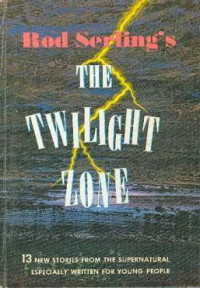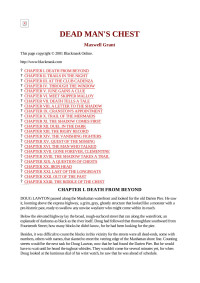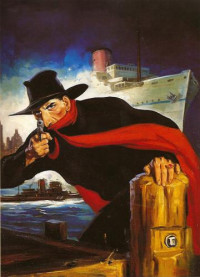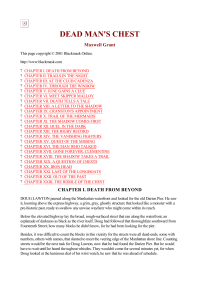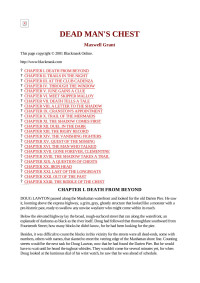
The Shadow 322 Dead Man's Chest
Maxwell Grant
DEAD MAN'S CHEST was originally published in the Fall, 1948 issue of The Shadow Magazine. It's a tale of Cuban gold, lost for many years. The search for the gold also becomes a search for a killer, as men begin to die. Death from a knife thrust in the back, under impossible conditions. The Shadow must unravel the strange clue uttered by a dying sea captain, "Dead Man's Chest!"
Our proxy hero is tall, rangy Doug Lawton of Oklahoma. He has come to New York to follow a clue to the location of lost Cuban gold. The gold was owed to his great-uncle since the time of the Spanish-American War. It was lost under strange circumstances, and young Doug is in New York following a years-old trail.
A sinister message tells him to visit the waterfront and listen for tugboat whistles. The whistles will form a code that will lead him to information about the lost gold. He hears the whistles in the dark, he follows the coded instructions, and finds Tom Jeffrey, a tattoo artist with information. But before Jeffrey can impart his vital information, he is murdered right in front of young Doug Lawton. Murdered by a knife in the back. Yet no one else is in the tattoo artist's studio.
But Doug Lawton isn't the only one drawn into the intrigue of the missing Cuban gold. There's also beautiful, young June Getty. Fifty years ago, her grandfather was to be paid the million dollars in gold for assisting the Cuban insurgents in their revolt against Spain. But he never received the payment. So she, too, has a claim on the lost gold treasure.
Our story follows the two as they work separately to find the gold, and finally join forces to not only discover the resting place of the treasure but fight off the hoards of thugs and killers on their trail. Assisting them in their battles is The Shadow and his agents. Yes, The Shadow enters the fray to make sure that the murderers come to justice and that the rightful heirs receive the missing million in gold bars.
This Shadow mystery harkens back to the early days of The Shadow pulp magazine. Reading it unaware, the reader would never guess it was from 1948. It reads much more like something from 1935. And author Walter Gibson placed nothing in the story to indicate the time period in which it took place. There was no mention of the recent world war. No mention of housing shortages. The story was intentionally written to resemble the classic Shadow of the glory years.
A little background on The Shadow's pulp history is in order, here. When this story was written, Walter Gibson had returned from a two-year hiatus of authoring The Shadow mysteries. He created the character in 1931 and wrote the vast majority of the pulp novels until early 1946. By that time, editorial changes at publisher Street & Smith demanded shorter and shorter Shadow stories.
Gibson's first Shadow stories in 1931 were over sixty-thousand words, but that quickly dropped to the mid-forty thousand, where it stayed for years. In the early 1940's, due to cutbacks in paper due to wartime shortages, the size of The Shadow Magazine shrunk. And along with the smaller "digest" size, came a reduced page count and shorter stories. By 1946, the word-count on the stories was in the low thirty-thousand range. They were now "novelettes" rather than novels.
Not only did the size of the stories change, but the character of The Shadow had metamorphisized as well. What began as an all-powerful, cloaked avenger of the night who shot to kill, had changed into a all-too-human crimefighter who shot to disable. He was even occasionally hounded by the police in some stories, who after all those years, were fickle enough to believe he had turned to crime.
Yes, the character had changed. But the biggest changes were yet to come. Creator and author Walter Gibson left the magazine in 1946 after a contract dispute. Street & Smith brought in a new "Maxwell Grant" in the person of Bruce Elliott. And for the next two years, The Shadow was a changed man. The fifteen Shadow stories written by Bruce Elliott are widely considered to be the worst of the entire eighteen-year run of the magazine.
The Shadow, as written by Bruce Elliott, was just a regular crimefighter named Lamont Cranston. In some stories, the cloaked character of The Shadow only appeared briefly in one or two scenes. In a few of his stories, no mention was ever made of The Shadow; they were simply stories of criminologist Lamont Cranston. The length of the stories dropped to an all-time low of eighteen thousand words. How far The Shadow had fallen!
After two years of declining readership, Street & Smith Publications, in a desperate attempt to revive their flagship pulp magazine, renegotiated with Walter Gibson and he returned to penning the adventures of The Shadow under the Maxwell Grant name. Unfortunately, it was a case of "too little; too late" and the magazine ceased publication after only five more issues. But during this period of five issues, the Shadow of old was back.
Gibson's job was to bring back the classic Shadow of old, and he did it well. Back was the moody atmosphere of the night, the sinister whispering Shadow and all his agents. The size of the stories themselves ballooned back up to over fifty-thousand words. It was a time of renaissance for The Shadow. And this story, "Dead Man's Chest" was the second of those five Shadow stories. Walter Gibson was back in his top form, and so was his most famous character The Shadow.
To satiate the readers who longed for the familiar old characters, Walter Gibson re-introduced a large contingent of agents and friends of The Shadow for these final stories. In this one, we again meet with contact-man Burbank, underworld agent Cliff Marsland, long-time agent Harry Vincent, reporter Clyde Burke and hunchy little trailer Hawkeye.
And let's not forget hackie Moe Shrevnitz. He's introduced as Moe Shrevnitz, but then referred to as "Shrevvy" from then on. That's one of the few clues that tips today's reader to the fact that this isn't one of the 1930's stories. The nickname "Shrevvy" wasn't introduced until the "Margo Lane" era in 1941. Margo, it should be noted, does not appear in this story.
Gibson also brought in many of the lesser agents. Miles Crofton is included in this story, although he doesn't get to pilot any airplanes. In fact, his former role as The Shadow's pilot isn't even mentioned here. He's just treated as another agent. And also treated as just another agent is Chance LeBrue, who specialized as a stunt driver in the earlier stories. He doesn't get to drive, here. Instead, he takes on duties trailing suspects. And finally, Dr. Rupert Sayre, The Shadow's personal physician, is mentioned but doesn't actually appear.
Let's not forget Inspector Joe Cardona of the New York Police Department, and Commissioner Ralph Weston. Both are back in action, here. No sign of Detective Sergeant Markham, though.
The Shadow, himself, is still a master of disguise. He appears here not only as his black-cloaked self, but also in his oft-used disguise as Lamont Cranston. And he briefly appears as old Isaac Twambley. He even appears at the end as his true self, Kent Allard. Author Walter Gibson doesn't indicate that Allard is The Shadow's true identity, however. It's treated as just another guise of The Shadow. Still, it's nice to see him.
Many of the familiar trappings are present. We get to see The Shadow climb down the outside of a six-story building, using his flexible rubber discs. And he is still using his flashlight with the colored lenses to flash coded messages to his agents. And of course, the sliding tray in the back of Moe Shrevnitz's cab still contains the black outfit of The Shadow.
A couple things were conspicuously absent, however. There is no sign of those messages to the agents that The Shadow writes in the vivid blue ink that disappears when exposed to the air. And we don't get any visits of the sanctum. Still, Gibson was able to introduce much of what made the "old" Shadow great. So I won't complain.
There are very few clues to today's reader that this wasn't actually one of the 1930's Shadow stories. As mentioned above, Moe Shrevnitz is referred to as "Shrevvy" which is one tip-off. Another hint is that in the earlier stories, the thugs always met at underworld dives that were bars and taverns. Places like the Pink Rat or The Black Ship. In this story, the meeting places for the waterfront rats has become restaurants, cafes and fish-and-chip places. But those two items were the only two things that made this story stand out from the typical 1935 Shadow tale.
This Shadow pulp mystery was a real treat for me to read. And I can only imagine that it must have been doubly so for readers in 1948 who had been forced to put up with two years of reading Bruce Elliott's version of The Shadow. It's The Shadow that we all love. And it's a great mystery, to boot! A rousing adventure with a climax that takes place aboard a sailing ship on the high seas.
Our proxy hero is tall, rangy Doug Lawton of Oklahoma. He has come to New York to follow a clue to the location of lost Cuban gold. The gold was owed to his great-uncle since the time of the Spanish-American War. It was lost under strange circumstances, and young Doug is in New York following a years-old trail.
A sinister message tells him to visit the waterfront and listen for tugboat whistles. The whistles will form a code that will lead him to information about the lost gold. He hears the whistles in the dark, he follows the coded instructions, and finds Tom Jeffrey, a tattoo artist with information. But before Jeffrey can impart his vital information, he is murdered right in front of young Doug Lawton. Murdered by a knife in the back. Yet no one else is in the tattoo artist's studio.
But Doug Lawton isn't the only one drawn into the intrigue of the missing Cuban gold. There's also beautiful, young June Getty. Fifty years ago, her grandfather was to be paid the million dollars in gold for assisting the Cuban insurgents in their revolt against Spain. But he never received the payment. So she, too, has a claim on the lost gold treasure.
Our story follows the two as they work separately to find the gold, and finally join forces to not only discover the resting place of the treasure but fight off the hoards of thugs and killers on their trail. Assisting them in their battles is The Shadow and his agents. Yes, The Shadow enters the fray to make sure that the murderers come to justice and that the rightful heirs receive the missing million in gold bars.
This Shadow mystery harkens back to the early days of The Shadow pulp magazine. Reading it unaware, the reader would never guess it was from 1948. It reads much more like something from 1935. And author Walter Gibson placed nothing in the story to indicate the time period in which it took place. There was no mention of the recent world war. No mention of housing shortages. The story was intentionally written to resemble the classic Shadow of the glory years.
A little background on The Shadow's pulp history is in order, here. When this story was written, Walter Gibson had returned from a two-year hiatus of authoring The Shadow mysteries. He created the character in 1931 and wrote the vast majority of the pulp novels until early 1946. By that time, editorial changes at publisher Street & Smith demanded shorter and shorter Shadow stories.
Gibson's first Shadow stories in 1931 were over sixty-thousand words, but that quickly dropped to the mid-forty thousand, where it stayed for years. In the early 1940's, due to cutbacks in paper due to wartime shortages, the size of The Shadow Magazine shrunk. And along with the smaller "digest" size, came a reduced page count and shorter stories. By 1946, the word-count on the stories was in the low thirty-thousand range. They were now "novelettes" rather than novels.
Not only did the size of the stories change, but the character of The Shadow had metamorphisized as well. What began as an all-powerful, cloaked avenger of the night who shot to kill, had changed into a all-too-human crimefighter who shot to disable. He was even occasionally hounded by the police in some stories, who after all those years, were fickle enough to believe he had turned to crime.
Yes, the character had changed. But the biggest changes were yet to come. Creator and author Walter Gibson left the magazine in 1946 after a contract dispute. Street & Smith brought in a new "Maxwell Grant" in the person of Bruce Elliott. And for the next two years, The Shadow was a changed man. The fifteen Shadow stories written by Bruce Elliott are widely considered to be the worst of the entire eighteen-year run of the magazine.
The Shadow, as written by Bruce Elliott, was just a regular crimefighter named Lamont Cranston. In some stories, the cloaked character of The Shadow only appeared briefly in one or two scenes. In a few of his stories, no mention was ever made of The Shadow; they were simply stories of criminologist Lamont Cranston. The length of the stories dropped to an all-time low of eighteen thousand words. How far The Shadow had fallen!
After two years of declining readership, Street & Smith Publications, in a desperate attempt to revive their flagship pulp magazine, renegotiated with Walter Gibson and he returned to penning the adventures of The Shadow under the Maxwell Grant name. Unfortunately, it was a case of "too little; too late" and the magazine ceased publication after only five more issues. But during this period of five issues, the Shadow of old was back.
Gibson's job was to bring back the classic Shadow of old, and he did it well. Back was the moody atmosphere of the night, the sinister whispering Shadow and all his agents. The size of the stories themselves ballooned back up to over fifty-thousand words. It was a time of renaissance for The Shadow. And this story, "Dead Man's Chest" was the second of those five Shadow stories. Walter Gibson was back in his top form, and so was his most famous character The Shadow.
To satiate the readers who longed for the familiar old characters, Walter Gibson re-introduced a large contingent of agents and friends of The Shadow for these final stories. In this one, we again meet with contact-man Burbank, underworld agent Cliff Marsland, long-time agent Harry Vincent, reporter Clyde Burke and hunchy little trailer Hawkeye.
And let's not forget hackie Moe Shrevnitz. He's introduced as Moe Shrevnitz, but then referred to as "Shrevvy" from then on. That's one of the few clues that tips today's reader to the fact that this isn't one of the 1930's stories. The nickname "Shrevvy" wasn't introduced until the "Margo Lane" era in 1941. Margo, it should be noted, does not appear in this story.
Gibson also brought in many of the lesser agents. Miles Crofton is included in this story, although he doesn't get to pilot any airplanes. In fact, his former role as The Shadow's pilot isn't even mentioned here. He's just treated as another agent. And also treated as just another agent is Chance LeBrue, who specialized as a stunt driver in the earlier stories. He doesn't get to drive, here. Instead, he takes on duties trailing suspects. And finally, Dr. Rupert Sayre, The Shadow's personal physician, is mentioned but doesn't actually appear.
Let's not forget Inspector Joe Cardona of the New York Police Department, and Commissioner Ralph Weston. Both are back in action, here. No sign of Detective Sergeant Markham, though.
The Shadow, himself, is still a master of disguise. He appears here not only as his black-cloaked self, but also in his oft-used disguise as Lamont Cranston. And he briefly appears as old Isaac Twambley. He even appears at the end as his true self, Kent Allard. Author Walter Gibson doesn't indicate that Allard is The Shadow's true identity, however. It's treated as just another guise of The Shadow. Still, it's nice to see him.
Many of the familiar trappings are present. We get to see The Shadow climb down the outside of a six-story building, using his flexible rubber discs. And he is still using his flashlight with the colored lenses to flash coded messages to his agents. And of course, the sliding tray in the back of Moe Shrevnitz's cab still contains the black outfit of The Shadow.
A couple things were conspicuously absent, however. There is no sign of those messages to the agents that The Shadow writes in the vivid blue ink that disappears when exposed to the air. And we don't get any visits of the sanctum. Still, Gibson was able to introduce much of what made the "old" Shadow great. So I won't complain.
There are very few clues to today's reader that this wasn't actually one of the 1930's Shadow stories. As mentioned above, Moe Shrevnitz is referred to as "Shrevvy" which is one tip-off. Another hint is that in the earlier stories, the thugs always met at underworld dives that were bars and taverns. Places like the Pink Rat or The Black Ship. In this story, the meeting places for the waterfront rats has become restaurants, cafes and fish-and-chip places. But those two items were the only two things that made this story stand out from the typical 1935 Shadow tale.
This Shadow pulp mystery was a real treat for me to read. And I can only imagine that it must have been doubly so for readers in 1948 who had been forced to put up with two years of reading Bruce Elliott's version of The Shadow. It's The Shadow that we all love. And it's a great mystery, to boot! A rousing adventure with a climax that takes place aboard a sailing ship on the high seas.
年:
1948
出版社:
Street & Smith
语言:
english
文件:
EPUB, 194 KB
IPFS:
,
english, 1948
 Amazon
Amazon  Barnes & Noble
Barnes & Noble  Bookshop.org
Bookshop.org  转换文件
转换文件 更多搜索结果
更多搜索结果 其他特权
其他特权 
